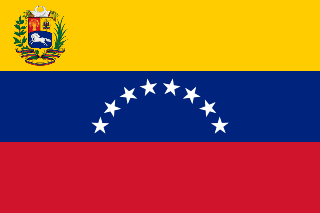
A pandemic is an epidemic of disease that has spread across a large region; for instance multiple continents, or even worldwide. This may include communicable and noncommunicable diseases.

Measles is a highly contagious infectious disease caused by the measles virus. Symptoms usually develop 10–12 days after exposure to an infected person and last 7–10 days. Initial symptoms typically include fever, often greater than 40 °C (104.0 °F), cough, runny nose, and inflamed eyes. Small white spots known as Koplik's spots may form inside the mouth two or three days after the start of symptoms. A red, flat rash which usually starts on the face and then spreads to the rest of the body typically begins three to five days after the start of symptoms. Common complications include diarrhea, middle ear infection (7%), and pneumonia (6%). Less commonly seizures, blindness, or inflammation of the brain may occur. Other names include morbilli, rubeola, red measles, and English measles. Rubella, which is sometimes called German measles, and roseola are different diseases caused by unrelated viruses.
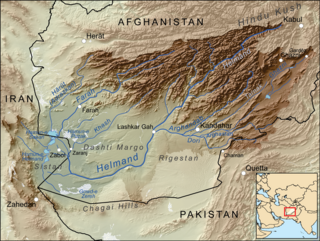
The Helmand River is the longest river in Afghanistan and the primary watershed for the endorheic Sistan Basin. This river is not the Sarasvati of the Rig Veda as some assume.
Napoleon Alphonseau Chagnon is an American anthropologist, professor of anthropology at the University of Missouri in Columbia and member of the National Academy of Sciences. Chagnon is known for his long-term ethnographic field work among the Yanomamö, a society of indigenous tribal Amazonians, in which he used an evolutionary approach to understand social behavior in terms of genetic relatedness. His work has centered on the analysis of violence among tribal peoples, and, using socio-biological analyses, he has advanced the argument that violence among the Yanomami is fueled by an evolutionary process in which successful warriors have more offspring. His 1967 ethnography Yanomamö: The Fierce People has become a bestseller and is frequently assigned in introductory anthropology courses.

Uncontacted peoples, also referred to as isolated people or lost tribes, are communities who live, or have lived, either by choice or by circumstance, without significant or first contact with greater civilization. Few people have remained totally uncontacted by modern civilization.

The Trojan Range is a mountain range rising to 2,760 metres (9,055 ft), extending northward from Mount Francais along the east side of Iliad Glacier, Anvers Island, in the Palmer Archipelago of the British Antarctic Territory. It was surveyed by the Falkland Islands Dependencies Survey (FIDS) in 1955 and named by the UK Antarctic Place-Names Committee (UK-APC) for the Trojans, one of the opposing sides in the Trojan War in Homer's Iliad.

Pico da Neblina National Park is a national park in the state of Amazonas in the north of Brazil, bordering on Venezuela. It overlaps with several indigenous territories, which creates tensions over land use, as does the military presence due to the border location. The park includes lowlands around the Rio Negro, partly flooded, and mountains that include the highest peak in Brazil, after which the park is named. The wide variety of physical environments supports great biodiversity, including several endangered species.

Davi Kopenawa Yanomami, name also written Davi Kobenawä Yanomamö, is a Yanomami shaman and Portuguese-speaking spokesperson for the Yanomami Indians in Brazil. He became known for his advocacy regarding tribal issues and Amazon rainforest conservation when the tribal rights organization Survival International invited him to accept the Right Livelihood Award on its behalf in 1989. Yanomami spoke to both the British and Swedish parliaments about the catastrophic impact on Yanomami health as a consequence of the illegal invasion of their land by 40,000 ‘garimpeiros’ or goldminers. Prince Charles publicly called the situation ‘genocide’. In a seven-year period from 1987-1993 one fifth of the Yanomami died from malaria and other diseases transmitted by the miners.
Of all Yanomami who have emerged as public figures, probably the most important is Davi Kopenawa Yanomami.
Omai is a Creator deity (god) mentioned by Davi Kopenawa Yanomami, a shaman and Portuguese-speaking spokesperson of the Yanomami índios of Brazil.

Achí is one of the 46 municipalities of the Bolívar department in the Caribbean Region of Colombia. It is crossed by the Cauca River and borders the Sucre department in the so-called Momposina Depression.
Bryncethin is a small village in the County Borough of Bridgend, South Wales, located just north of Junction 36 of the M4 Motorway and approximately 3 miles north of the county town of Bridgend. The population of the ward was 1,319 in 2011.
Ibirapuitã is a municipality in the state of Rio Grande do Sul, Brazil.

Demini River is a river in the Amazon rainforest of the state of Amazonas, Brazil. It is a tributary of the Rio Negro.
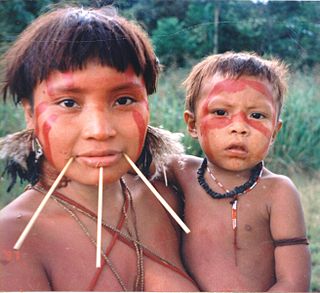
The Yanomami people are an indigenous group who live in the Amazon Rainforest along the borders of Venezuela and Brazil. There are estimated to be only approximately 35,000 indigenous people remaining. They are interfluvial Indians who live in small villages along the Mavaca and Orinoco Rivers, with each village consisting of a single shabono, or communal dwelling. Largely uncontacted by the outside world, the Yanomami have been affected by illnesses introduced by gold miners since the 1980s. Anthropological studies have emphasized that the Yanomami are a violent people, and although this can be true, the women of the Yanomami culture generally abstain from violence and warfare. Although males dominate the Yanomami culture, Yanomami women play an important role in sustaining their lifestyle.
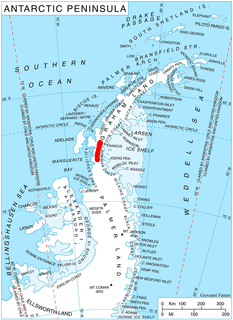
Chamberlin Glacier is a glacier on the east side of Hemimont Plateau which flows northeast into Whirlwind Inlet about 4 nautical miles (7 km) southeast of Matthes Glacier, on the east coast of Graham Land. It was discovered by Sir Hubert Wilkins on a flight of December 20, 1928, and in 1940 was photographed from the air by the United States Antarctic Service. It was charted in 1947 by the Falkland Islands Dependencies Survey, who named it for American glaciologist and geomorphologist Thomas C. Chamberlin, educator and professor of geology at the Universities of Wisconsin and Chicago.
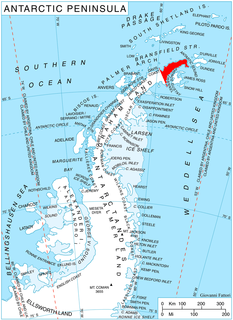
Crown Peak is an ice-covered peak, 1,185 metres (3,890 ft) high, topped by a conspicuous crown-shaped ice formation. It forms the highest summit and the south end of the Marescot Ridge and lies 10 nautical miles (19 km) east of Cape Roquemaurel on the northwest side of the Trinity Peninsula. It was named by the Falkland Islands Dependencies Survey following their survey of the area in 1946.
The process that has been described as the genocide of indigenous peoples in Brazil began with the Portuguese colonization of the Americas, when Pedro Álvares Cabral made landfall in what is now the country of Brazil in 1500. This started the process that led to the depopulation of the indigenous peoples in Brazil, because of disease and violent treatment by European settlers, and their gradual replacement with colonists from Europe and Africa. This process has been described as a genocide, and continues into the modern era with the ongoing destruction of indigenous peoples of the Amazonian region.

Measles is extremely contagious but infection results in lifelong immunity, so its continued circulation in a community depends on the generation of susceptible hosts by birth of children. In communities which generate insufficient new hosts the disease will die out. This concept was first recognized by Bartlett in 1957, who referred to the minimum number supporting measles as the critical community size (CCS). Analysis of outbreaks in island communities suggested that the CCS for measles is c. 250,000.

The University of Arizona is a public research university in Tucson, Arizona. Founded in 1885, the UA was the first university in the Arizona Territory. As of 2017, the university enrolls 44,831 students in 19 separate colleges/schools, including the University of Arizona College of Medicine in Tucson and Phoenix and the James E. Rogers College of Law, and is affiliated with two academic medical centers. The University of Arizona is governed by the Arizona Board of Regents. The University of Arizona is one of the elected members of the Association of American Universities and is the only representative from the state of Arizona to this group.

The Federal University of Rio de Janeiro or University of Brazil is a public university in the state of Rio de Janeiro, Brazil. UFRJ is the largest federal university in the country and is one of the Brazilian centers of excellence in teaching and research. In terms of scientific, artistic and cultural productions it is recognized nationally and internationally due to the great teachers, researchers, reviews and assessments made by international agencies. In 2017 QS World University Rankings ranked UFRJ as the best Brazilian federal university, as well as the third best university in the country occupying the seventh position among institutions of Latin America. In 2016 and 2017 the Ranking Universitário Folha (RUF) ranked UFRJ as the best university in Brazil and the best Federal University in the country. The Center for World University Rankings (CWUR) published in 2017 UFRJ as the second best university in the world in Zoology field.

Darkness in El Dorado: How Scientists and Journalists Devastated the Amazon (2000) is a polemical book by author Patrick Tierney, in which the author accuses geneticist James Neel and anthropologist Napoleon Chagnon of conducting human research without regard for their subjects' well-being while conducting long-term ethnographic field work among the indigenous Yanomamö, in the Amazon Basin between Venezuela and Brazil. He also wrote that the researchers had exacerbated a measles epidemic among the Native Americans. Tierney also claims that Jacques Lizot and Kenneth Good committed acts of sexual impropriety with Yanomamö.



